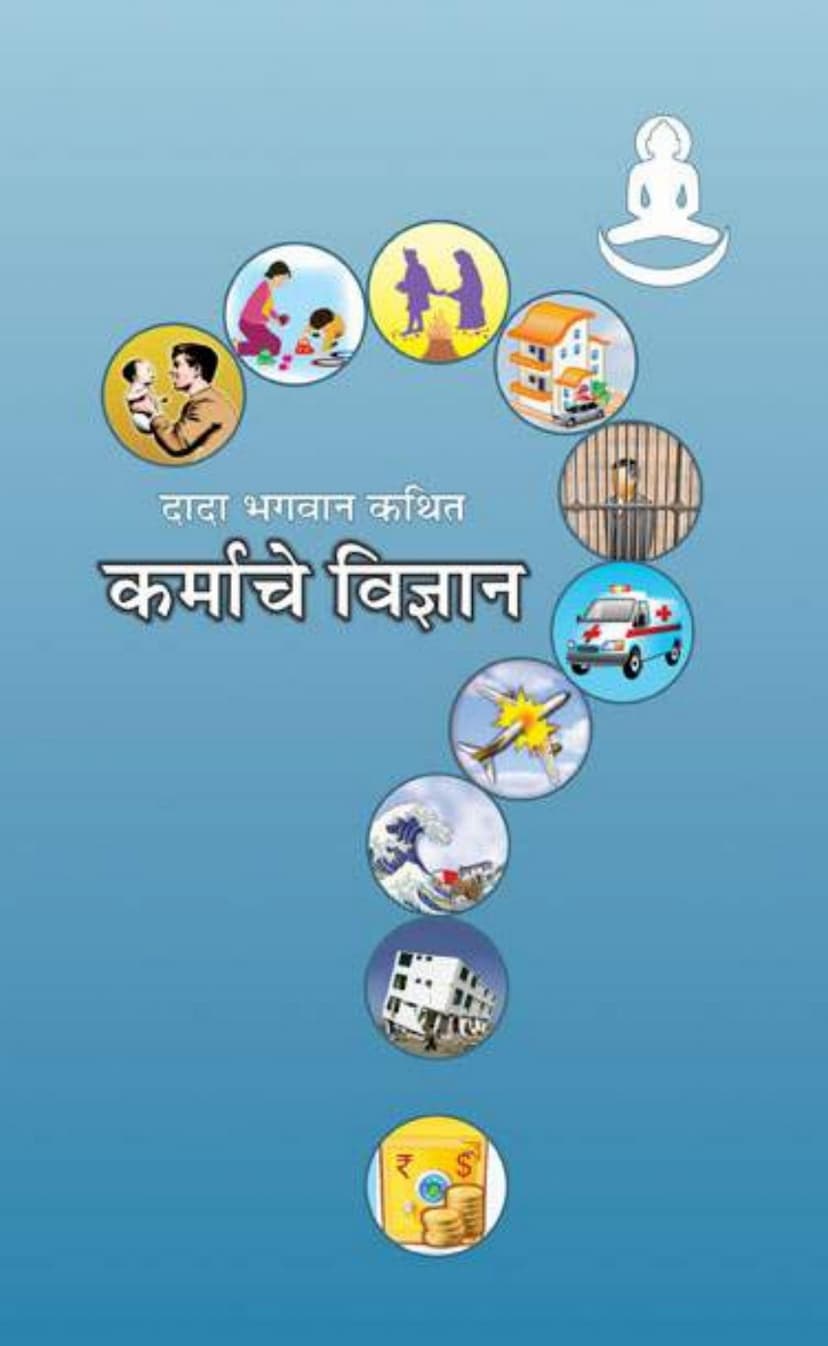Karmache Vignan
Added to library: September 2, 2025

Summary
Here's a comprehensive summary of the Jain text "Karmache Vignan" (The Science of Karma) by Dada Bhagwan, based on the provided pages:
Overall Theme:
"Karmache Vignan" is a profound exploration of the science of karma, as expounded by Dada Bhagwan, a self-realized spiritual master. The book delves into the intricate workings of karma, explaining how it binds us, how we can break free from its cycle, and the ultimate path to liberation (moksha). It emphasizes that true understanding of karma leads to liberation from suffering and the attainment of the pure self (Soul).
Key Concepts and Teachings:
- Karma as a Science: Dada Bhagwan presents karma not as a blind destiny or divine punishment, but as a precise and scientific process. Every action, thought, and intention creates a corresponding reaction and consequence.
- The Nature of Karma:
- Cause and Effect: The core principle is that every action (cause) has an effect. This isn't just about external actions, but also internal thoughts and intentions.
- The "Doer" (Karta): Karma is bound through the illusion of being the "doer" (karta). When one believes "I am doing this," karma is created. The realization that "I am not the doer" and "Someone else is doing this" leads to the cessation of karma binding.
- Attributed Feelings (Aropit Bhav): Karma binds through "attributed feelings" or the ego. Believing "I am Chandubhai" (or one's own name) is an illusion. Identifying with the body, relationships, or roles creates karma.
- Charge and Discharge: The text uses the analogy of charging and discharging batteries. Past karmic seeds (charges) manifest as experiences (discharges) in the present. Current actions and thoughts create new karmic charges for the future.
- Subtle vs. Gross Karma: There's a distinction between gross karma (visible actions and their immediate effects) and subtle karma (internal intentions and attitudes that bind for future lives). While gross karma might have immediate consequences, it's the subtle karma that determines future destinies.
- Vayavasthit Shakti (Self-Organized Energy): Dada Bhagwan explains that the universe is governed by "Vayavasthit Shakti," a scientific circumstantial evidence or natural law. Karma is just a part of this larger system. Vayavasthit Shakti orchestrates events, and karma is the seed that ripens within this framework.
- The Illusion of "I": The fundamental misunderstanding that leads to karma is the mistaken identification with the ego ("I"). The book stresses the importance of the question, "Who am I?" The answer lies in realizing the true Self, the Soul, which is distinct from the body, mind, and ego.
- Breaking the Cycle of Karma:
- Knowledge of the Self (Atma-Gyan): The ultimate solution lies in attaining Self-knowledge. When one realizes the pure Soul, the illusion of the "doer" (karta) dissolves.
- Pratikraman: The practice of sincere repentance and asking for forgiveness (pratikraman) is highlighted as a way to neutralize or burn karmic seeds.
- Living Without Attachment: Acting in the world without attachment, without the egoistic claim of "I am the doer," allows one to perform actions without binding new karma.
- Understanding Miracles vs. Science: Events that appear miraculous are explained as the result of Vayavasthit Shakti and past karma, not divine intervention.
- Types of Karma:
- Sanchit Karma: Accumulated karma from past lives, stored like a stock.
- Prarabdha Karma: The portion of Sanchit karma that is ripe and ready to be experienced in the present life.
- Kriyamana Karma: Karma being created in the present moment through actions, thoughts, and intentions.
- Responsibility: The book strongly emphasizes that every individual is entirely responsible for their own karma and its consequences. There is no external agent, including God, who is responsible.
- The Path to Liberation:
- Akram Vignan (Non-Sequential Science): Dada Bhagwan's path is described as "Akram," meaning without steps or stages. It's a direct, shortcut method to Self-realization.
- Meeting the Self-Realized Being: Attaining liberation requires meeting a living, Self-realized soul who can impart this knowledge.
- Understanding the True Nature of Life: Recognizing that all experiences, whether pleasant or unpleasant, are the result of past karma and are impermanent.
- The Role of the Intellect and Knowledge: The intellect is seen as limited and often leads to confusion. True understanding comes from knowledge (gyan) and direct experience of the Self.
- Dealing with Relationships and Suffering: Conflicts in relationships (e.g., with mother-in-law, spouse) are also viewed as manifestations of past karma. By understanding one's own role and seeing the other as a mere "instrument" (nimitta), one can avoid binding new karma.
- The Importance of Internal State: The book repeatedly stresses that it's the internal intention and feelings (bhav) that create karma, not the external actions themselves.
Structure and Presentation:
The book is presented in a question-and-answer format, reflecting Dada Bhagwan's discourses. This makes complex spiritual concepts accessible and engaging for the reader. The language, while a Marathi translation of Gujarati, aims to convey the directness and clarity of Dada Bhagwan's spoken words.
Conclusion:
"Karmache Vignan" offers a comprehensive and practical understanding of karma from a Jain perspective, as articulated by Dada Bhagwan. It empowers individuals with the knowledge that they are not victims of destiny but are the creators of their own experiences. By understanding the science of karma and realizing the true Self, one can break free from the cycle of suffering and attain liberation. The emphasis on "Vayavasthit Shakti" provides a scientific framework for understanding the order and functioning of the universe.